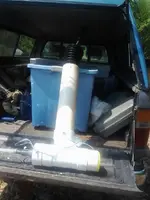Timberdoodle
Sr. Member
- Joined
- Oct 17, 2012
- Messages
- 316
- Reaction score
- 243
- Golden Thread
- 0
- Location
- Kingfield, Maine
- Primary Interest:
- All Treasure Hunting
In my experiences with a fluid bed I've learned that it's a very good idea to have the jet's angled downward to keep the material fluidized and this also aids in creating a material loop which sends material passing the jet stream downward to the bottom before it returns upward based on it's SG. I believe if your not maintaining a constant exchange and fluidization of the material throughout the collection chamber then the space taken up by a layered bed of material creates a restriction and will cause higher flow velocity through the chamber and the result over time is similar to a riffle that's packed with black sand - loss of gold. It is the key difference between a true fluid bed sluice and other concepts.








